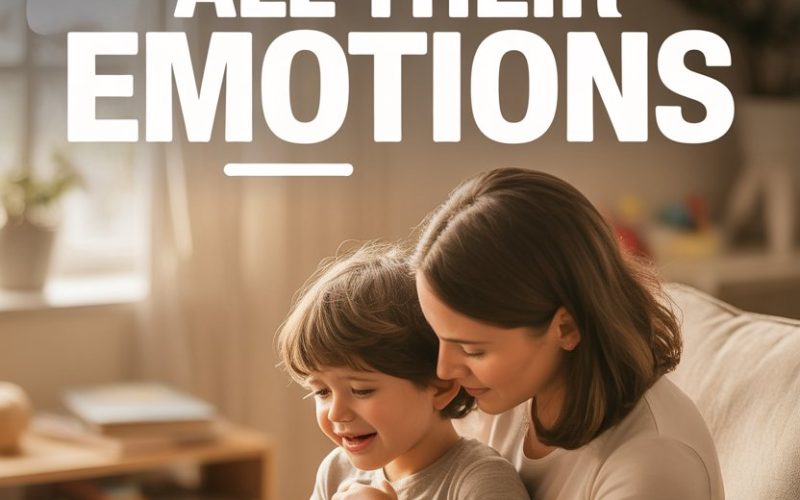Ever wish your child came with an instruction manual for feelings? Something with a troubleshooting section for “random sobbing during dinner” or “anger volcano during shoe-tying”?
While there’s no magic booklet, there are ways to help your child actually feel all their emotions (not just the Instagrammable ones) — even if you’re running on cold coffee and sheer will.
Here’s the comforting bit: You’re already halfway there by caring enough to read about it.
Now, let’s get into the good stuff.
Big Feelings Are Not Bad Feelings
Kids have feelings that spill out like an overstuffed laundry basket. Frustration when the blue cup is dirty. Devastation at the injustice of bedtime. Pure, unfiltered joy at spotting a worm after rain.
It’s tempting to try to tidy up all those feelings — to hush the tears, distract from the anger, or hurry joy along so you’re not late for school.
Here’s the plot twist: Every feeling deserves a seat at the table, even the messy ones.
Research from Yale’s Center for Emotional Intelligence shows that kids who can identify and express a full range of emotions handle stress better and have stronger relationships.
In other words, allowing your child to fully feel isn’t just “nice” — it’s necessary for healthy development.
Name It to Tame It
A two-year-old might scream over a dropped cracker for reasons that feel mysterious to adults. Labeling emotions can help — even when your child can’t.
Try phrases like, “You seem really disappointed that the cracker broke,” or “That was a big surprise, wasn’t it?”
This helps your child connect physical sensations (tight tummy, hot face) to words like ‘sad’, ‘worried’, or ‘mad’.
Dr. Dan Siegel, a leading expert on child brain development, calls this “Name it to Tame it.”
Neuroscience backs him up: Naming emotions activates the prefrontal cortex, which helps calm the amygdala (the brain’s emotional panic button).
Don’t worry about getting it wrong. If you say, “You look mad,” and your child snaps, “I’m not mad, I’m just tired!” — that’s still a win.
You’re modeling emotional vocabulary, and now you know tiredness is the culprit.
Model Emotional Honesty (Without Oversharing)
Kids don’t need to hear every detail about your stressful day or your existential dread over the electric bill. But showing basic emotional honesty is powerful.
Try: “I’m feeling a bit frustrated because my Zoom meeting froze again. I’m going to take a few deep breaths.”
You’re demonstrating that all feelings are allowed, and, crucially, that feelings can be managed.
Kids watch much more than they listen, as every parent who’s ever accidentally taught their child a creative swear word can confirm.
Validate Before Problem-Solving
Picture this: Your child is mid-tantrum because their toast is cut into rectangles instead of triangles.
The natural urge is to fix it. “I’ll make you new toast! Look, triangles!” Or, “It doesn’t matter, just eat it anyway.”
Try a pause. “That really upset you. You wanted triangle toast. It’s okay to feel angry about that.” Sit with them. Hug them, if they’ll have it.
Research published in the journal Emotion shows that validation reduces emotional distress much faster than logic or distraction.
A child who feels seen is a child who’s learning to trust their feelings — and yours.
Make Space for the Full Rainbow
Modern life is busy, noisy, and filled with “hurry up.” Emotional processing, on the other hand, is slow and spectacularly inconvenient.
Set aside time each day (even five minutes before bed counts) to check in. Try: “What was the best part of your day? The hardest? Anything surprise you?”
Don’t rush answers, and don’t be afraid of silence.
Books work wonders, too. Choose stories that feature a range of emotions — sadness, jealousy, joy, fear. Discuss how the characters feel and what they do. “How do you think the bear felt when his friend left?”
Stepping into another’s shoes builds empathy and normalizes big feelings.
If you’re looking for suggestions, the book The Color Monster is a parent favorite for younger kids, and Inside Out (the movie) is a surprisingly sophisticated lesson in why we need every emotion — not just the happy ones.
Teach Coping Tools, Not Suppression Tactics
No need to sign up for family yoga (unless you genuinely enjoy hearing “downward dog” shouted at 7 a.m.). Coping tools can be simple: Breathing exercises, squeezing a stress ball, drawing a picture of how anger feels.
Offer choices, and experiment together. “When I feel nervous, I like to count my breaths. Want to try with me?” Or, “Sometimes stomping my feet helps get my grumpy out. Want to stomp together?”
What doesn’t help: “Stop crying,” or “You’re being silly.” These phrases teach kids to stuff feelings down — where they usually pop out later at the supermarket queue, just in time for an audience.
A trick from child therapists: Have a “calm down corner” at home. No, it’s not a punishment zone. Stock it with pillows, books, or quiet toys.
The message is, “It’s okay to feel big feelings, and here’s a place to do it safely.”
Embrace the Mess (And the Humor)
Raising a child who feels all their emotions means accepting some mess. Sometimes literally.
There will be tears, snot, and that baffling phenomenon where sadness morphs into giggles and back again in thirty seconds flat.
You’re allowed to feel overwhelmed, too. Parenting isn’t about never losing your cool — it’s about coming back, apologizing if needed (“I yelled, and I wish I hadn’t. I was frustrated and tired”), and trying again.
Kids are natural comedians, especially when their emotions are huge. It’s okay to laugh together (not at them, though — only with).
Sometimes, laughter is the best way to move through tough feelings, and it lets your child know that emotions — even big ones — don’t have to be scary.
Keep the Door Open for All Feelings
Children sometimes pick up the idea that only “good” feelings are welcome, while anger, sadness, or jealousy need to be hidden. Push back against this by showing that all emotions are part of being human.
If your child says, “I’m angry at you,” resist the urge to shut it down. Try, “It’s okay to feel angry. Can you tell me more?”
This doesn’t mean you have to tolerate rude behavior — “You’re allowed to feel mad, but not to hit” — but it does mean the feeling itself is never wrong.
Dr. Lisa Damour, psychologist and author, explains that children thrive when parents create an atmosphere where every emotion can be discussed, not just the pleasant ones.
That doesn’t mean agreeing with every outburst, just acknowledging it.
Emotion Coaching in Action
Emotion coaching isn’t a mystical art — it’s a set of small, consistent habits. When your child is teetering on the edge of a meltdown, try these steps:
- Notice the feeling (“You seem really upset”).
- Name it (“Are you feeling sad because your friend couldn’t play today?”).
- Validate it (“That is really disappointing”).
- Offer comfort (“I’m here with you”).
- Help brainstorm ways to cope (“Would a cuddle or a drawing help?”).
It won’t always be perfect. Some days, you’ll get through three steps before someone throws a shoe. That’s okay. Progress, not perfection.
What About Your Own Feelings?
Here’s the sneaky secret: Kids learn emotional skills from watching you handle your own feelings.
If you grew up in a family where feelings were more suppressed than old leftovers at the back of the fridge, this might take practice.
Notice your emotions out loud: “I’m feeling a little anxious about this meeting, so I’m going to take a moment to breathe.” Show that grown-ups have feelings, too — and that those feelings can be managed.
Self-compassion is key. You’re not failing if you lose your patience. Repair is powerful. Apologize if needed, then move forward.
You’re showing your child that emotions can be survived and relationships can be repaired.
When to Seek Extra Help
Sometimes, big feelings are more than a phase.
If your child’s emotions seem overwhelming most of the time — or if sadness, worry, or anger get in the way of daily life — reaching out for professional support is a strong parenting move, not a sign of weakness.
Mental health resources and child psychologists are trained to support children and parents. The earlier you seek help, the easier it is to get back on track.
Don’t wait until you’re at the end of your rope (or hiding in the loo with chocolate).
Growing Emotional Muscles Together
Helping your child feel all their emotions is a lifelong process — for both of you. Some days will run smoother than others. You’ll have victories, like the day your child says, “I’m sad, but I know it will pass.”
You’ll have challenges, like the day their best friend moves away and the world feels wobbly.
Through it all, you’re building a foundation for resilience, empathy, and connection. Those big feelings aren’t obstacles — they’re stepping stones to your child’s most authentic, joyful self.
Keep the tissues handy. The rewards are pretty wonderful.





